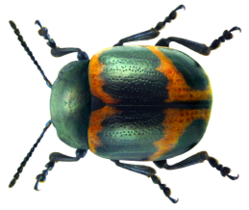| Labidomera | |
|---|---|
 | |
| Labidomera clivicollis | |
| Scientific classification | |
| Domain: | Eukaryota |
| Kingdom: | Animalia |
| Phylum: | Arthropoda |
| Class: | Insecta |
| Order: | Coleoptera |
| Suborder: | Polyphaga |
| Infraorder: | Cucujiformia |
| Family: | Chrysomelidae |
| Tribe: | Chrysomelini |
| Genus: | Labidomera Chevrolat in Dejean, 1836 |
| Species | |
See text | |
Labidomera is a genus of leaf beetles. [1]
